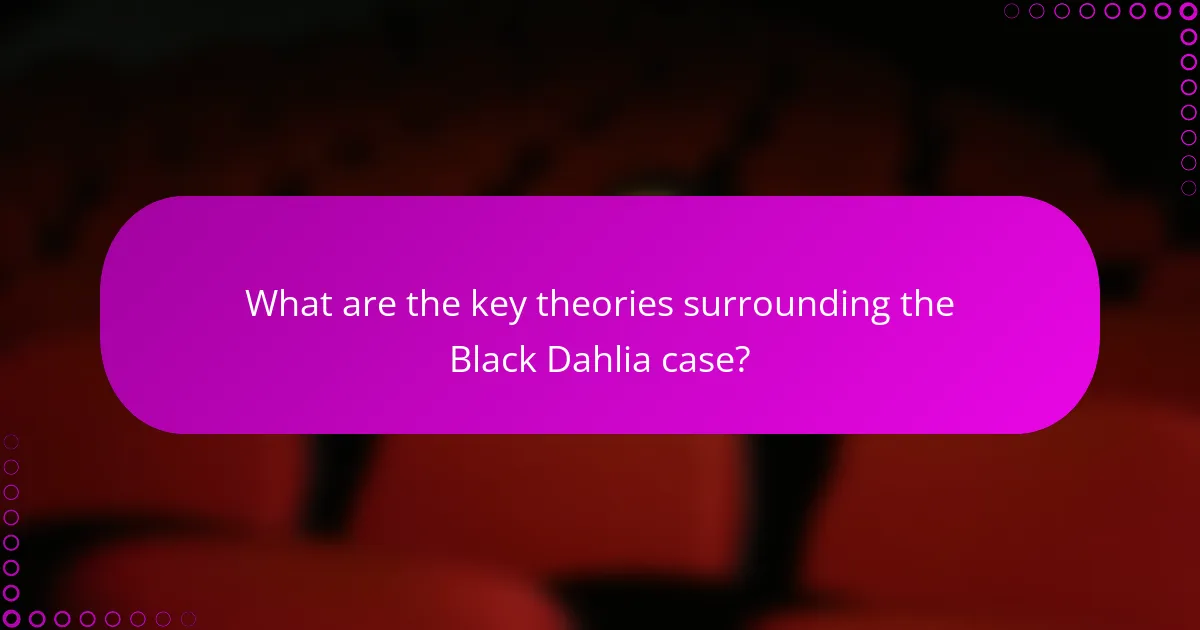The Black Dahlia case centers on the unsolved murder of Elizabeth Short, an aspiring actress found dead in Los Angeles in 1947. Her body was discovered mutilated in a vacant lot, leading to significant media attention and the emergence of various theories regarding her death. Key suspects include George Hodel, linked to the crime scene, and the possibility of involvement from Hollywood elites or personal vendettas due to Short’s tumultuous relationships. The case highlights the challenges of solving high-profile murders, the impact of media sensationalism, and the importance of forensic analysis in criminal investigations. Despite extensive efforts, the mystery of the Black Dahlia remains one of the most infamous unsolved cases in American history.

What is the Black Dahlia case?
The Black Dahlia case refers to the unsolved murder of Elizabeth Short in 1947. Elizabeth Short was an aspiring actress found dead in Los Angeles. Her body was mutilated and displayed in a vacant lot. The case garnered significant media attention at the time. It became one of the most famous unsolved murders in American history. Numerous theories and suspects emerged over the years. The name “Black Dahlia” was coined by the press due to her dark clothing and the film “The Blue Dahlia.” Despite extensive investigations, the case remains officially unsolved to this day.
Who was Elizabeth Short, the Black Dahlia?
Elizabeth Short, known as the Black Dahlia, was an American woman whose murder in 1947 gained widespread media attention. She was born on July 29, 1924, in Hyde Park, Boston. Short moved to Los Angeles in the early 1940s, aspiring to become an actress. Her body was discovered on January 15, 1947, in a vacant lot in Los Angeles. The gruesome nature of her murder shocked the public. The case remains unsolved, leading to numerous theories and speculation over the years. Short’s life and tragic death have since become a significant part of American crime history and pop culture.
What were the key events leading up to her murder?
The key events leading up to Elizabeth Short’s murder include her arrival in Los Angeles in 1943. She sought fame and worked various jobs. In late 1946, Short was seen with several men, including potential suspects. Witnesses reported her last known whereabouts near a bar in Hollywood. On January 15, 1947, her body was discovered in a vacant lot. The brutal nature of the crime shocked the public and media. Investigators found her body mutilated and drained of blood. The case quickly became a sensational media topic, leading to widespread public interest.
What are the significant details surrounding her death?
Elizabeth Short, known as the Black Dahlia, was found dead on January 15, 1947. Her body was discovered in a vacant lot in Los Angeles. The body was severely mutilated and drained of blood. Short had been cut in half at the waist. Her death was ruled a homicide. The case received extensive media coverage, sparking public fascination. Despite numerous leads, her murder remains officially unsolved. Investigators have pursued various theories regarding her death over the years.
What makes the Black Dahlia case a media sensation?
The Black Dahlia case became a media sensation due to its brutal nature and the mystery surrounding it. Elizabeth Short, the victim, was found murdered in 1947 in Los Angeles. The case featured graphic details that shocked the public. The media extensively covered the crime, fueling public fascination. Sensational headlines and speculation about the killer added to the intrigue. The case remains unsolved, which keeps interest alive. Additionally, Short’s nickname, “Black Dahlia,” contributed to her becoming an iconic figure in crime history. The combination of horror, mystery, and media frenzy made the case a lasting sensation.
How did the media coverage impact public perception?
Media coverage significantly shaped public perception of the Black Dahlia case. Sensational reporting created a widespread fascination with the murder. Newspapers published graphic details and speculative theories, fueling public intrigue. The portrayal of Elizabeth Short as a mysterious figure added to her notoriety. Coverage often emphasized sensational aspects over factual reporting. This led to a distorted public understanding of the case. The media’s framing influenced how the public viewed crime and victims. Ultimately, the intense media focus solidified the Black Dahlia case in American pop culture.
What role did sensationalism play in the reporting of the case?
Sensationalism played a significant role in the reporting of the Black Dahlia case. The media exaggerated details to attract public attention. Headlines often focused on the gruesome aspects of the crime. This approach heightened public interest and fear. Journalists speculated about the killer’s identity without substantial evidence. Such reporting led to a frenzy of theories and rumors. The sensational coverage overshadowed factual reporting and investigation. Ultimately, it shaped public perception and the narrative surrounding the case.
Why is the Black Dahlia case still relevant today?
The Black Dahlia case remains relevant today due to its enduring mystery and cultural impact. Elizabeth Short’s unsolved murder in 1947 captivated public attention. The gruesome nature of the crime shocked society and sparked widespread media coverage. This case has inspired numerous books, films, and documentaries. Theories surrounding the murder continue to intrigue true crime enthusiasts. The case raises questions about media ethics and sensationalism in reporting. Additionally, it highlights issues of misogyny and violence against women. The Black Dahlia has become a symbol of unresolved crime and societal fascination with the macabre.
What cultural impact has the case had over the years?
The Black Dahlia case has had a significant cultural impact over the years. It has inspired numerous films, books, and television shows. The case became a symbol of unsolved mysteries in American crime history. It has influenced the noir genre in literature and film, shaping public perceptions of crime in Los Angeles. The media coverage of the case highlighted sensationalism in journalism. This case has also sparked discussions about gender and violence against women. The enduring intrigue surrounding Elizabeth Short’s story continues to captivate audiences today. Additionally, the case remains a topic of interest in true crime communities and academic studies.
How has the case influenced popular media and art?
The Black Dahlia case has significantly influenced popular media and art. It has inspired numerous films, books, and television shows. The case’s mysterious nature captivates audiences, leading to various interpretations in storytelling. Notable films include “The Black Dahlia” directed by Brian De Palma, which dramatizes the events. Books like “The Black Dahlia” by James Ellroy explore the case in depth, blending fiction with real events. Additionally, the case has been referenced in television series such as “American Horror Story.” The enduring intrigue surrounding the case continues to inspire artists and creators, reflecting its impact on culture.

What are the key theories surrounding the Black Dahlia case?
The Black Dahlia case involves the unsolved murder of Elizabeth Short in 1947. Key theories surrounding her death include the involvement of a serial killer, possibly George Hodel. Hodel was a prime suspect due to circumstantial evidence and his alleged connection to the crime scene. Another theory suggests that Short was killed by someone in the Hollywood elite. This theory is based on her aspirations to be an actress and her connections in the film industry. A third theory posits that Short’s murder was a result of a personal vendetta. This is supported by her tumultuous relationships. Each theory reflects the complexity and intrigue of the case, contributing to its lasting legacy in American crime history.
What are the most prominent theories about the murderer?
The most prominent theories about the murderer of the Black Dahlia center around various suspects and motives. One theory suggests that George Hodel, a physician, was responsible due to circumstantial evidence and his connection to the victim. Another theory implicates a serial killer active in Los Angeles during that time. Some believe the murder was linked to organized crime, given the victim’s associations. Additionally, there are theories suggesting the involvement of law enforcement, as some officers had connections to the case. Each theory has its proponents and is supported by different pieces of evidence, but no definitive conclusion has been reached.
How do these theories differ in terms of evidence?
The theories surrounding the Black Dahlia case differ significantly in terms of evidence. Some theories rely on eyewitness accounts and circumstantial evidence. For example, the theory suggesting a connection to the Los Angeles Police Department cites purported insider knowledge. In contrast, other theories, such as those implicating specific individuals, depend on forensic evidence or lack thereof. For instance, the theory linking George Hodel to the murder is based on circumstantial evidence but lacks definitive forensic proof. Additionally, some theories are supported by detailed timelines and alibis, while others are more speculative. The variance in the strength and type of evidence leads to differing levels of credibility among the theories.
What are the implications of these theories on the investigation?
The implications of these theories on the investigation are significant. They shape the direction of inquiries and influence the interpretation of evidence. Each theory offers a different lens through which to view the case. For instance, theories suggesting involvement of high-profile individuals can lead investigators to re-examine alibis and motives. Conversely, theories focusing on serial killers may prompt a broader analysis of unsolved cases in the area. These theories also affect public perception and media coverage, which can pressure law enforcement to act. Ultimately, the prevailing theories can determine resource allocation and investigative priorities. Theories influence the exploration of leads and the assessment of suspects.
How have advancements in forensic science affected the case?
Advancements in forensic science have significantly impacted the investigation of the Black Dahlia case. Modern forensic techniques, such as DNA analysis, have enhanced the ability to identify potential suspects. These advancements allow for the re-examination of evidence collected at the crime scene. For instance, DNA profiling could potentially match biological samples to known individuals. Furthermore, improved forensic imaging techniques help in reconstructing crime scenes more accurately. Historical evidence, such as hair and fiber analysis, can now be evaluated with greater precision. These tools provide law enforcement with new leads that were previously unavailable. Overall, advancements in forensic science have revitalized interest in solving the Black Dahlia case.
What new technologies could potentially solve the case?
DNA analysis could potentially solve the Black Dahlia case. Advances in forensic DNA technology allow for the analysis of degraded samples. This includes mitochondrial DNA testing, which can be effective on older evidence. Additionally, genealogical DNA databases can help identify potential suspects. These databases have successfully solved cold cases in recent years. For example, the Golden State Killer was identified through this method. Furthermore, digital imaging technology can enhance crime scene photos. This could reveal details previously overlooked. Overall, these technologies offer promising avenues for new leads in the investigation.
How have cold case investigations evolved since the original case?
Cold case investigations have significantly evolved since the original Black Dahlia case. Advances in forensic science have introduced new techniques such as DNA analysis. These methods allow investigators to re-examine evidence that was previously untestable. Additionally, the use of modern technology has improved data management and case tracking. Law enforcement agencies now share information more effectively through databases. Public interest and media coverage have also increased, leading to more tips and leads. Cold case units have been established in many police departments to focus specifically on unresolved cases. This evolution reflects a growing commitment to solving historical crimes.

What lessons can be learned from the Black Dahlia case?
The Black Dahlia case teaches several important lessons about crime investigation and media influence. First, it highlights the challenges of solving high-profile murders. The case remains unsolved despite extensive investigation. Second, it illustrates the impact of media sensationalism on public perception. The coverage often distorted facts and fueled speculation. Third, it emphasizes the need for thorough forensic analysis. Advances in forensic science could potentially yield new insights. Lastly, it shows the importance of maintaining confidentiality in investigations. Leaks can compromise cases and mislead the public. These lessons underscore the complexities involved in criminal investigations and the role of media in shaping narratives.
What can modern law enforcement learn from the investigation?
Modern law enforcement can learn the importance of thorough evidence collection from the Black Dahlia investigation. The case highlighted the need for meticulous documentation of crime scenes. Inadequate forensic practices at the time led to missed opportunities for crucial evidence. Additionally, the investigation demonstrated the impact of media on public perception and police work. Law enforcement should manage media relations carefully to avoid misinformation. The case also emphasizes the necessity of collaboration among agencies. Sharing information can enhance investigative efforts. Lastly, the enduring cold case serves as a reminder of the value of cold case units in solving historical crimes.
How can public engagement improve cold case resolutions?
Public engagement can significantly improve cold case resolutions by increasing the flow of information and generating new leads. Engaging the community encourages individuals with potential insights to come forward. This has been demonstrated in various cases where tips from the public led to breakthroughs. For instance, in 2019, a cold case in California was solved after a social media campaign prompted a witness to share critical information. Additionally, public interest can increase resources allocated to investigations, as seen in high-profile cases that garnered media attention. Overall, active community involvement fosters a collaborative environment for solving cold cases.
What resources are available for those interested in the Black Dahlia case?
Books such as “The Black Dahlia” by James Ellroy provide in-depth narratives. Documentaries like “The Black Dahlia Murder” explore the case visually. Online databases contain police reports and newspaper articles from 1947. Websites dedicated to true crime offer forums for discussion and analysis. Academic journals may feature studies on the case’s impact on media and culture. Podcasts often discuss theories and new findings related to the Black Dahlia. Local libraries may have archives with primary sources. Museums in Los Angeles sometimes hold exhibits related to the case.
Where can one find reliable information and analysis on the case?
Reliable information and analysis on the Black Dahlia case can be found in various sources. Books such as “The Black Dahlia” by James Ellroy provide detailed narratives and analysis. Academic journals often publish articles on the case, offering insights based on historical research. Documentaries and reputable true crime podcasts also explore the case extensively. Websites dedicated to criminal history and forensic science frequently update their content with new findings. Additionally, newspapers from the time of the murder, like the Los Angeles Times, contain original reports and analyses. These sources collectively contribute to a comprehensive understanding of the case.
What books or documentaries provide in-depth insights into the Black Dahlia case?
Books that provide in-depth insights into the Black Dahlia case include “The Black Dahlia” by James Ellroy. This novel is a fictionalized account based on the real-life murder. Another significant book is “Black Dahlia, Red Rose” by Piu Eatwell. It explores various theories and the historical context of the case.
Documentaries such as “The Black Dahlia Murder” by the History Channel delve into the investigation and theories surrounding the case. “Crime Scene: The Vanishing at the Cecil Hotel” also touches on the Black Dahlia case within a broader context of unsolved murders in Los Angeles.
These sources are recognized for their detailed examination of the case and its impact on popular culture.
The Black Dahlia case centers around the unsolved murder of Elizabeth Short, an aspiring actress found dead in Los Angeles in 1947, whose gruesome death shocked the public and garnered significant media attention. The article explores key events leading up to her murder, significant details surrounding her death, and the sensational media coverage that shaped public perception. It also discusses various theories regarding potential suspects, the impact of advancements in forensic science, and the cultural significance of the case over the years. Additionally, the article highlights lessons learned from the investigation and resources available for those interested in further exploring the Black Dahlia case.


